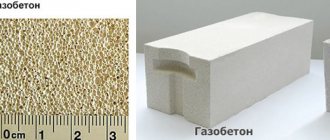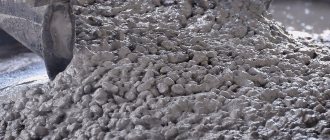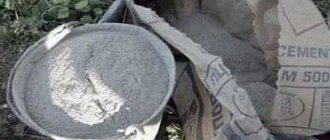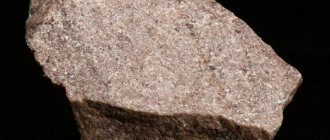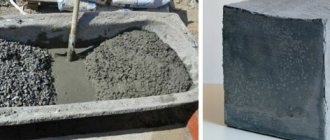A large number of materials are used in construction, but concrete can be considered one of the main ones. It is used to create a foundation, to level the surface, and in many other cases. There are a large number of varieties of this building material, from which you can choose those that have suitable characteristics. In order to rationally plan its use, we figure out how to calculate concrete - how much is needed in a given case.
You need to know how to correctly determine the flow rate Source refite.ru
Information on the purpose of the calculator.
The online calculator for a monolithic strip foundation
is designed to calculate the dimensions, formwork, quantity and diameter of reinforcement and the volume of concrete required for the construction of this type of foundation. To determine the appropriate type of foundation, be sure to contact a specialist.
All calculations are performed in accordance with SNiP 52-01-2003 “Concrete and reinforced concrete structures”, SNiP 3.03.01-87 and GOST R 52086-2003
A strip foundation is a monolithic closed reinforced concrete strip running under each load-bearing wall of a building, thereby distributing the load along the entire length of the strip. Prevents subsidence and changes in the shape of the building due to the action of soil heaving forces. The main loads are concentrated at the corners. It is the most popular type among other foundations in the construction of private houses, as it has the best ratio of cost and necessary characteristics.
There are several types of strip foundations, such as monolithic and prefabricated, shallow and deep buried. The choice depends on the characteristics of the soil, the expected load and other parameters that must be considered in each case individually. Suitable for almost all types of buildings and can be used when constructing basements and basements.
The design of the foundation must be carried out especially carefully, since if it is deformed, this will affect the entire structure, and correcting errors is a very complex and expensive procedure.
When filling out the data, pay attention to the additional information with the sign.
The following is a complete list of calculations performed with a brief description of each item. You can also ask your question using the form on the right.
Concrete rings
What is concrete goods? These are reinforced concrete products. Precast concrete rings consist of reinforced steel and concrete. The purpose of these rings is to build wells; this is its frame. You can also calculate the volume of concrete in reinforced concrete rings by turning to Internet resources, using various online calculators for calculations. You only need to know the height, diameter and thickness of the ring.
But there is also a formula for calculating it yourself. It looks like this: V=H*S, where H is the height of the ring, S is its area. To determine the area, you need to calculate the parameters of the outer circle; for this, one-half of the number “pi” is multiplied by the diameter and by 2. It looks like this: S= 1/2π*D*2. Then you need, using the same formula, to calculate the inner circle, and then the area of the inner circle is subtracted from the area of the outer circle, and we get the parameters of the ring.
General information on the calculation results.
- The total length of the tape is the perimeter of the foundation.
- The area of the base of the tape is the area where the foundation rests on the soil. Corresponds to the dimensions of the required waterproofing.
- External side surface area - Corresponds to the area of the required insulation for the external side of the foundation.
- Volume of concrete - The volume of concrete required to pour the entire foundation with the given parameters. Since the volume of concrete ordered may differ slightly from the actual one, as well as due to compaction during pouring, it is necessary to order with a 10% reserve.
- Concrete weight - The approximate weight of concrete based on average density is indicated.
- Load on the soil from the foundation - Distributed load over the entire area of the support.
- Minimum diameter of longitudinal reinforcement bars - Minimum diameter according to SP 52-101-2003, taking into account the relative content of reinforcement from the cross-sectional area of the tape.
- Minimum number of rows of reinforcement in the upper and lower chords - The minimum number of rows of longitudinal bars in each chord to prevent deformation of the tape under the influence of compression and tension forces.
- Minimum diameter of transverse reinforcement bars (clamps) - Minimum diameter of transverse and vertical reinforcement bars (clamps) according to SP 52-101-2003.
- Pitch of transverse reinforcement bars (clamps) - Pitch of stirrups necessary to prevent shifts of the reinforcement cage when pouring concrete.
- The amount of overlap of reinforcement - When fastening sections of rods with an overlap.
- Total length of reinforcement - The length of all reinforcement for tying the frame, taking into account the overlap.
- Total reinforcement weight - The weight of the reinforcement cage.
- Formwork board thickness - Calculated thickness of formwork boards in accordance with GOST R 52086-2003, for given foundation parameters and at a given support spacing.
- Number of boards for formwork - The amount of material for formwork of a given size.
What methods can you use to calculate the volume of concrete?
Construction work is preceded by project development. At this stage, the type of foundation base is determined, and the volume of concrete solution required for the construction of the foundation is calculated. At the design stage, the need for mortar for pouring monolithic walls and concrete floors is calculated. The cubic capacity of the concrete mixture required to complete the work is determined by the volume of the building structures being concreted.
Various methods are used to perform calculations:
- manual. It is based on calculating the volumes of the foundation, main walls and floor. The calculation is made using a regular calculator using school formulas for calculating volume and does not take into account the shrinkage coefficient of concrete. The resulting value differs slightly from the results of calculations using software;
- program. The initial data entered into the program about the type of foundation, its dimensions, design features and concrete grade are quickly processed. As a result, a fairly accurate result is produced, which you can use as a guide when purchasing building materials for constructing a foundation base, building walls or pouring a floor.
Features when calculating the volume of concrete
To obtain an accurate result, it is not enough to take into account only the internal size of the formwork. The second method is more accurate, since the online calculator takes into account all the data: type of foundation, cross-section of the foundation base, presence of reinforcement cage and brand of mortar.
General calculation rules
You can calculate the volume of concrete using an online calculator or, remembering your school geometry course, do all the calculations yourself.
As initial data you can use:
- foundation configuration;
- its parameters: length, width, thickness, depth.
A concrete structure necessarily contains reinforcement, which also occupies a certain volume. But since it is insignificant (less than 1% of the entire foundation), this variable is usually neglected.
The resulting volume value must be increased by approximately 10%, since losses of concrete are inevitable during its transportation, preparation and pouring. In addition, the mixture thickens and decreases in volume when bayoneted as air is removed from it.
You should be careful when making calculations: as a rule, if you need to urgently order an additional portion of concrete, the costs of its preparation and delivery increase significantly.
What data will be required?
For the calculation, the following aspects must be taken into account:
The height of the base (h), that is, the distance from the sole to the edge. The standard is about sixty centimeters above the soil surface plus depth.- Width (b). It usually depends on the mass of the building, the characteristics of the soil cushion, and the expected thickness of the walls.
- The total length of the foundation (l) is the length, which is calculated as the sum of all load-bearing structures located both outside and inside.
If the base is deepened to 1.6 m, then the overall result should be, taking into account the height of 2.2 m. The depth is determined by the characteristics of the soil, and the type of concrete used is also taken into account. The type of building and its purpose are taken into account.
The sole should be buried below the freezing level, the minimum value for this is fifteen centimeters.
There are online calculators where you just need to enter data to get a calculation . However, you can do this yourself.
When constructing a small building, approximate volume values are allowed, but if the building is large or must last for many years, you should not be careless with the calculations.
How to calculate how many cubes of concrete are needed for a strip foundation?
The foundation is a very important and expensive element of a building. The durability and strength of a house or outbuilding depends on how correctly it is built (filled). and considering that, depending on specific conditions, the cost of a strip foundation can range from 30 to 70 percent of the construction cost, it is very important to correctly calculate how much concrete will be needed for its construction.
In this case, the following factors influence the design of the strip foundation:
- Relief of the land plot for construction of the structure;
- Soil type;
- Soil freezing depth. Affects the amount of foundation heaving;
- Height of groundwater. It also affects the amount of foundation heaving (linear movement in winter).
The calculations use the usual mathematical and geometric formulas that are taught as part of the high school curriculum.
How to calculate how much concrete is needed for a strip foundation.
Strip foundations are widely used by private developers in the construction of low-rise residential buildings, bathhouses, garages, sheds, temporary buildings and other similar buildings. The popularity of strip foundations lies in the simplicity of the design and the possibility of independent calculation and construction.
How to calculate a cube of concrete for a foundation calculator.
To calculate the amount of concrete needed to pour the foundation, you will need to calculate the volume of the foundation in cubic meters. In this regard, two options are possible. The first option is that the length, width and height of the structure are the same along the entire perimeter of the “ribbon”. The second option is that the height and width of the foundation are variable.
You can calculate how many cubes of concrete are needed for the foundation according to the first option as follows.
For example, by measuring the length of the foundation “ribbon” (perimeter), width and height, you received the following initial data:
- Foundation perimeter (L): 40 meters. Important! The perimeter is measured not along the external or internal border, but strictly along the center of the foundation trench;
- Height(H) 1.5 meters;
- Width(S) 0.7 meters.
We substitute the initial data into the formula for the volume of the parallelepiped V=LxHxS: V=40×1.5×0.7=42 m3. To pour a strip foundation you will need 42 cubic meters of concrete.
An example of calculating concrete for a strip foundation.
How to count cubes of concrete for the foundation of a house.
Let's say your foundation with a total length of 40 meters consists of two parts that differ in width: 10 meters of tape 0.7 meters wide and 30 meters of tape 0.5 meters wide. In this case, we use the same formula for the volume of a parallelepiped, only we make two calculations: for a “piece” of 10 meters (V1) and a “piece” of 30 meters (v2). Then we sum up the resulting volumes and get the volume of concrete to be poured (V)
- V1=10×1.5×0.7=10.5 m3;
- V2=30×1.5×0.5=22.5 m3;
- V=10.5+22.5=33 cubic meters of concrete.
Types of concrete
The following types of solution are distinguished:
- By appointment. These include ordinary and special solutions. The former are used for the construction of industrial and civil buildings, while special ones are used for the construction of hydraulic, road and other structures.
- By binder. These include cement, gypsum, silicate solutions, etc.
- By placeholders. There are concrete with dense, porous and special additives.
- According to hardening conditions. They are divided into hardening in a natural environment, under conditions of wet and warm processing at normal atmospheric pressure, and during processing with heat and moisture at atmospheric pressure above normal (autoclave hardening).
How much cement will be needed?
To mix concrete for pouring a strip foundation, you need to know how many components are required: cement, sand, crushed stone and water. In general, M200 grade concrete is used for the construction of strip foundations. According to GOST, concrete M200 is mixed in the following proportions of components:
- Cement – 1 part:
- Sand – 2.8 parts;
- Crushed stone – 4.4 parts;
- Water – 20% of the total volume.
Assuming that: 1 m3 of concrete weighs about 1,500 kg, 1 m3 of Portland cement weighs approximately 1,300 kg, 1 m3 of crushed stone 1,450 kg, 1 m3 of sand weighs 1,700 kg, to prepare 1 cubic meter of M200 grade concrete you will need: 255 kg of cement, 1,127 kg of crushed stone, 714 kg of sand and approximately 190 liters of water.
Calculation of how much concrete is needed for the foundation.
Accordingly, for the foundation according to the first option, 42 m3 × 225 kg = 9,450 tons of cement will be needed, and for the foundation according to the second option, 33 m3 × 225 = 7,425 tons of cement. It is worth noting here that the example of how to calculate how much concrete is needed in terms of calculating the components is approximate and requires clarification in each specific case, depending on the true mass of the building materials you imported.
Expert advice
When calculating the volume of concrete using a calculator or manually, you need to carefully double-check the data, and only then make the final purchase of building materials. And in this situation, it’s not even about money, but about the quality of the work done, how reliable and durable the floor will be.
If you use a calculator to calculate a floor screed, you must first decide what brand of screed to make, how to strengthen it, and how economically you want to approach this matter.
To save concrete, you can add a coarse fraction, such as gravel or slag, to half the floor.
If we talk about the mass of the screed, then you can make it yourself; we use the following proportion: for one part of cement we put two parts of sand and three parts of crushed stone, or screenings. You can also make the composition only from sand and cement; each master has his own methods, taking into account the characteristics of the initial state of the place for laying the floor. Quickly calculate the required amount of sand and cement using a calculator.
In order to strengthen the screed, a reinforcing mesh or fiber is used, such material is attached to the base, and the fiber is mixed into the concrete to form a screed.
How to protect concrete
In construction, waterproofing helps protect concrete. There are concepts of primary and secondary protection. Primary protection includes a set of measures taken for initial rational protection, for example, the choice of the correct shape, material, thickness of the concrete coating layer, etc. This type of protection also includes impregnation of concrete with special waterproofing mixtures, for example, penetrating.
Secondary protection includes measures for additional coating of concrete. For this purpose, various means are used, thin-layer impregnations, highly filled coatings and self-leveling floors. Foundations, for example, are waterproofed first with roofing felt, and then, when it is completely ready, with bitumen mastic.
It is not so difficult to calculate the volume of concrete yourself, having all the parameters at hand and knowing the formula. It’s even easier to do this with the help of special programs. A concrete volume calculator will greatly simplify the task.
How to calculate the cubic area of a foundation - examples.
Today, depending on the soil on which the building is planned to be erected, three main types of primary elements are used.
How to count cubes of concrete for a foundation.
Each of the above types of foundation has its own advantages and disadvantages. This is due to the fact that each type of foundation behaves differently on different soils, depending on the number of storeys of the building being constructed.
Monolithic.
It is a lattice monolithic slab made of reinforced concrete. It is made by pouring the entire area of the future building with concrete. This type of foundation is very popular when constructing buildings on floating or loose soils.
How to calculate the foundation.
- Ease of manufacture.
- The ability to erect buildings on soils that have buoyancy or large subsidence.
- Due to the need for a large amount of concrete and reinforcement, this type of foundation is expensive.
- A very labor-intensive manufacturing process.
It is made of reinforced concrete and is laid only under the load-bearing walls of the building and between room partitions. This type of primary element is preferably used for buildings with heavy walls or ceilings. Also for buildings in which basement equipment is required.
Calculate how many cubes of concrete are needed for the foundation.
- High strength.
- Long service life.
- Possibility of use for houses of different shapes.
- Due to the need to carry out excavation work, the construction process is greatly delayed.
- High economic costs for materials.
- Labor-intensive process.
Columnar.
It is one of the most common types of bases, as it has a low manufacturing cost. As a rule, it is used on floating soils for buildings with light walls. It is made by installing reinforced concrete pillars, and the space between them is filled with earth.
How to count cubes of concrete for the foundation of a private house.
- Does not require labor-intensive construction costs.
- Low manufacturing cost.
- Difficult to install.
- Cannot be used for buildings with heavy walls.
- Low stability on floating soils.
The main aspect of choosing a foundation is the type of soil on which the building is planned to be built. Also, the choice of the primary element depends on the type of building, its number of storeys, the weight of the walls and ceilings.
The influence of soil on the depth of foundation.
Ignorance of the characteristics of the soil on which it is planned to erect any building can lead to the fact that it begins to sag and collapse.
As a rule, the top layer of earth has a significant amount of organic residues, which affects its uneven subsidence and shrinkage. Consequently, such a layer of soil cannot be used as a cushion for the base.
Coarse, medium sandy and gravelly soils are best for foundations. The minimum depth for laying can be 0.5 meters. If the soil consists of fine sand or sandy loam, the groundwater level should be taken into account. Since sand, when filled with water, loses its load-bearing properties. Also, when such soil freezes, it can swell and sag unevenly.
As for clayey and sandy loam soils, they have good load-bearing properties, but when wet they begin to sag under their own weight.
In order to determine at what depth it is necessary to lay the foundation, you need to be guided by the following features.
- The number of floors of the building, the type of its construction, the weight of the walls and ceilings.
- The magnitude of the loads on the future foundation.
- The depth of the primary element in neighboring buildings (if they are present).
- Geological and hydrogeological properties of the soil on which construction is planned.
- The base of the soil under the foundation should not be heaving.
- The maximum depth of soil freezing in places where construction is planned.
Having all the information about the features described above, you can determine the most suitable depth for laying the foundation.
Formula for calculating the cubic area of the foundation.
How to calculate a cube of concrete for a foundation.
To calculate the cubic area of the primary element, use the volume calculation formula. For which I use the following data:
These data are multiplied together to obtain the cubic area of the base. Example WxHxD = cubic area. It is also worth remembering that concrete tends to shrink when it dries, this occurs due to the evaporation of water from it, so when calculating the cubic area it is worth taking this factor into account. The percentage by which concrete shrinks depends on the brand of concrete and you can find out this data from its specification.
Calculation with a calculator
There is a special program: online concrete volume calculator. You just need to enter the data in the table; there are explanations for each action. You can calculate how many materials are needed for concrete, sand or crushed stone, for example.
A convenient way to calculate the volume of concrete and its binding components. It is also possible to calculate for one batch or even a bucket. Of course, this calculation will be approximate, definitely, you need to try kneading and look at the result.
This applies to manual mixing of all ingredients. With production mixing, all indicators are, of course, more accurate. Using a calculator, you can also save your time; you do not need to derive all the calculations using formulas yourself. In addition, the possibility of errors is minimal when calculating online. Nobody wants to overpay if the error is large, and then look for a place where this concrete can be determined. And when counting down, of course, you don’t want to call a concrete mixer several times and pay extra for the delivery of concrete. Many calculators have hints.
How to calculate.
Each type of primary element has its own way of calculating the required volume of concrete. Also, to calculate it, you need to know the type of soil and its load-bearing properties. Calculation of the volume of the underlying material for each type is carried out as follows:
- Monolithic slab. To calculate the slab base, you need to know the area of the building being erected and the thickness of the poured primary element. Having these values, it is enough to multiply them together to obtain the required number of cubes of concrete. Also, if the structure of the foundation contains stiffening ribs, it is necessary to calculate the volume of each rib and add them to the total number of cubic meters of the foundation.
- Tape base. To calculate the volume of a strip primary element, it is enough to divide it into conditional walls. Then calculate their volume by multiplying their width by height and length. The results obtained must be summarized. In this way, it will be known how many cubic meters of concrete are needed to lay the strip foundation.
- Columnar base. The volume of a pile element is calculated in the following way: the volume of one pile is multiplied by their number, resulting in the required amount of concrete. The only difficulty in calculating a pile foundation is calculating the volume of one column, since their shape can be either cylindrical or pentagonal. The volume of simple cylindrical shapes is calculated as follows: the area of the circle (3.14*R^2, where R is the radius of the pile, half its diameter) of the base of the pillar is multiplied by its height.
Also, when calculating the volume of the primary basis, more complex calculations may arise. For example, when several types of foundation are used at one facility. In such cases, it is necessary to make a separate calculation for each type, and then summarize the results obtained.
What should be taken into account when calculating?
A more accurate determination of the amount of concrete mixture used can be achieved by:
- Characteristics of the soil, its heaving.
- Concrete shrinkage coefficient. Whatever the potting mix is, it will shrink slightly in volume as it cures. The amount of mortar that will be required when constructing the foundation must be greater to cover this point.
The level at which the aquifer is located also influences what brand of cement to choose, as well as how much sand and additional additives are required.
Correction factors help to clarify the volume; in addition, some other aspects, such as the thickness of the gravel and sand cushion or the width of the installed formwork, also introduce errors.
The shrinkage rate of concrete ranges from 1.5 to 3 percent . Typically a coefficient value of 1.1 is used. This means that the concrete mixture must be at least ten percent more than the expected volume of the finished base. The amount of reinforcement does not have a particular influence on the volume of the required concrete mixture.
If the soil layer is not reliable enough, backfilling or even replacement is required. These include clastic soils, soils with a high peat content, loams, and sandy loams.
Weak soils require calculations for maximum loads , which helps to calculate the impact that the soil will subsequently have on the foundation. Rocky soils are the strongest; coarse soils are also considered suitable as a base for a foundation.
Formula and accounting of coefficients
The strip type of foundation is used both by owners in the construction of private housing and by large companies. It itself is a rectangular structure consisting of a reinforcement frame and concrete.
You can carry out calculations either using programs on the corresponding websites on the network, or independently.
Formula to clarify the volume expended: V (volume) = h (height) * b (width) * l (length of the foundation strip)
The formula can only be used with these parameters only when pouring concrete into ideally rigid formwork and for concrete preparation. Because The cubic capacity is influenced by many factors (compaction coefficient, formwork leaks, concrete residue in concrete pump pipes, etc.).
To understand the issue, it is worth considering an example:
- at the future foundation, the length of 1 wall is 30 meters (24 m is the length of the base under the outer walls, 6 m is the length of the lintel under the 1st of the internal walls);
- width is 0.4 meters;
- height is 1.5 meters.
The calculation will look like this: 30*0.4*1.5 = 18 cubic meters of concrete mixture. If it is necessary to add a correction factor of 1.1, this is done like this: 18 * 1.1 = 19.8 cubic meters the volume of concrete required.
We must not forget about the technical holes that are required for communications . Even if it seems that their size is insignificant, they take up a lot of space. It is usually recommended to subtract the volume under them from the volume obtained by the formula.
Calculating the volume does not seem too complicated, but you need to remember that the design of the base may turn out to be more complicated and individual elements will have to be calculated additionally. The final result is influenced by the characteristics of the compositions and additives that are used to strengthen the base.
Experts believe that during preliminary calculations it is permissible to increase the obtained value by ten to twenty percent.
How many cubes of concrete are needed for the foundation?
To calculate the number of cubes of concrete, many people use an online calculator. But you can also do this yourself by using the concrete volume formula to calculate. First you need to consider what kind of foundations there are, and, based on their composition, choose a certain formula.
The foundation can be: strip, pile and slab; there are also many other types of foundation, but it is these three that use concrete for pouring.
Formula for strip foundation. Before making the calculation, you need to find out the width and height of the foundation strip. Then we multiply the width by the height and get the volume of concrete needed for pouring. It looks like this: V=S*L, where V is the volume of concrete, S is the cross-sectional area, L is the length of the foundation strip. To get the S value, you need to multiply the width of the tape by the height.
For example, the following values are given: 50 cm - width of the tape, height - 180 cm, length - 49 m. Solution: V = 49 * 0.5 * 1.8 = 44.1 cubic meters of concrete.
Formula for pile foundation. S=3.14*r, S – surface area of one pillar, r – radius of the pile.
V=H*n, where H is the height of each foundation pillar, and n is the number of pillars. For example, the diameter of the pillar is 20 cm, the length is 2 meters. 0.0628 cubic meters of concrete will be required.
Formula for slab foundation. V=S*H. S is the total area of the entire slab, and H is the thickness of the slab. For example, for a slab 5 m long, 5 m wide and 0.15 m thick, you will need: V=5*5*0.15=3.75 cubic meters of concrete.
Slab base
A slab foundation is one of the types of shallow foundations that is used in low-rise construction in the case of complex soils, for example, heaving or unevenly settling. It is a monolithic rectangular or square slab with a thickness of 0.3 to 0.5 m.
To calculate a cube of concrete, it is enough to find the product of the following quantities:
- width;
- length;
- height.
If the foundation design includes stiffening ribs, the volume of each rib is calculated separately. The obtained values are summed up and added to the volume of the slab.
For the foundation
When calculating the amount of concrete needed for the foundation, they are guided by the approved project. When calculating, both parts of the structure are taken into account - above-ground and in the ground. The cross-section of the reinforcement, if any, and the type of base are also taken into account.
The latter could be:
- tape;
- pile;
- columnar with grillage;
- in the form of a solid slab.
Calculation for strip foundation
This design is used for the construction of low-rise buildings. It combines relative simplicity with high strength characteristics.
In order to determine the required value, you need to multiply the cross-section of the foundation strip by its length.
To calculate the amount of concrete you will need the width and height of the concrete layer. The latter is defined as the sum of the sizes of the underground and above-ground parts.
It should be noted that the shape of the strip foundation is complex. In this case, concrete is laid not only along the external walls, but also lintels are made from it, which must also be taken into account. You cannot simply use the perimeter of the building as the length of the tape. It is recommended to mentally divide the structure into sections of simple shape. Calculate their volume, and then add up all the resulting values.
Calculation of consumption for a pile foundation
When a columnar foundation is made, it uses piles that are immersed in the soil. Sometimes, instead, concrete is poured into specially prepared wells.
This foundation is used, in particular, in situations where the bearing layer is relatively deep.
In the case when the cross-section of the pillars is circular, the volume of one pile is calculated by the formula:
Rev = 3.14 * High * Rad ** 2,
where the following notations are used:
- About is the volume of one pile;
- Height – its height;
- Rad is the radius of its cross-section.
In this case (Rad ** 2) means squaring.
To calculate concrete and find out how much of it is required for all piles, you need to multiply the resulting value by their number.
This can be clarified using the following example. When the diameter of the column is 30 cm, the height is 1.8 m, and the quantity is 21, then using the specified formula you can find out the required amount of material. To do this, you need to perform the following calculations.
Rev = (3.14 * 1.8 * 0.15 ** 2) * 21 = (3.14 * 1.8 * 0.025) * 21 = 0.1413 * 21 = 2.97 cc m
In this way, you can calculate the cubic capacity of concrete and find out what the cost of concrete will be when using any number of piles.
How to calculate the volume of concrete on piles
A columnar foundation consists of piles immersed in the soil or pouring reinforced concrete into pre-drilled wells. This type of foundation is used for the construction of light buildings on swelling soils or when the load-bearing layer is deep and is a popular design due to its ease of manufacture and fairly large savings in building materials. When the column foundations have a circular cross-section, the calculation is carried out based on the cross-sectional area using the formula:
S = 3.14 x R2where
R – column radius;
The result must be multiplied by the height (H) and the number of columns.
So, with a table diameter of 0.2 m, we have a cross section of 3.14 x (0.1 m)2 = 0.0314 m2, with a height of 2 m, the required volume of concrete for one product is 0.0628 m3. Using this method, you can calculate the volume of concrete for piles of any size.
For square piles, the calculation is carried out similarly.
It is important to calculate in advance how many and what kind of engineering structures https://betoncentr2000.ru/inzhenernye_sooruzhenija_kommunikacii.php will be needed, so that during the construction process it does not turn out that this important issue was not provided for.
Features of using floor screed mortar
To ensure that the final result of calculating the volume of concrete for construction work on floor screed does not change radically, several factors must be taken into account during such work:
- area of the room where renovation is planned;
- initial amount of floor; the thickness of the concrete pouring layer will depend on this indicator;
- brand of cement and quality of sand.
Pouring the floor
Floor screed - leveling the surface with a concrete mixture before starting finishing work. The thickness of the screed varies from 4 to 10 cm depending on the curvature and defects of the floor. For a relatively flat surface, concrete calculations are carried out according to the standard scheme.
In rooms with uneven floors, builders determine the volume of pouring based on the average height. When measuring walls, the minimum (Hmin) and maximum (Hmax) height points in the room are determined. The height of the standard fill (4 cm) is added to the difference value and divided in half:
Having received the average floor height, builders calculate the volume of concrete poured using a standard formula.
To obtain accurate calculations, it is customary to use construction calculators. Knowing the parameters of the future structure, you can calculate its dimensions and the required amount of concrete. Reinforcing elements make up from 5 to 10% of the total boundaries of the base and are not taken into account in the calculations. Traditionally, this error is leveled out by installation losses when pouring the material.
Calculation of slab size
A slab is a monolithic fill, the area of which coincides with the area of the building. When constructing slab foundations, stiffeners are used. They are also taken into account in cubic capacity calculations.
The general formula for a monolith includes the area (S) and thickness (H) of the slab:
V=S*H, or V=a*b*h, where:
- a – base width;
- b – its length;
- h – height.
It is suitable for calculating the cubic capacity of walls (minus the parameters of window and door openings), reinforced concrete floors, swimming pools, basements, and slab foundations.
The volume of stiffeners is calculated using the formula for a truncated pyramid:
- V is the volume of the stiffener;
- H – rib height;
- S1 – area of the lower base;
- S2 – area of the upper base.
To calculate the overall dimensions of the slab, the known volumes are added together.
Calculating the cubic capacity of concrete to level the floor
It is important to understand exactly how to calculate how much concrete is needed for the floor. If you incorrectly determine the tonnage of the solution, prepare it less, and then you will need to buy more ingredients. It is better to avoid such situations, because a high-quality screed must be poured in one go. Therefore, we will study all the features of the calculations in order to avoid mistakes.
We multiply the following quantities:
- floor area. Multiply the width by the length;
- screed thickness. Everything is simple here;
- consumption coefficient 1.02.
For example, S of the floor is 30 m2, the thickness of the screed is 0.05 m. To carry out the work, we will need 1.53 m3 of cement mortar. Things are more complicated when there are differences in the base. Then the height of the concrete layer is determined by the lowest point (the largest number is taken).
We need to know the volume in order to select the components that need to be purchased. So be guided by the following:
- The construction documentation indicates that to prepare one cubic meter of cement composition, 490 kg of binder is required. Leveling the floor is allowed using a dry compound of a grade not lower than M400. Moreover, the higher the grade, the more sand you can add;
- By multiplying the cubic capacity and the original unit - 490, we will get a figure that explains how much binder to buy. It is better to make a purchase with a small reserve, but not too significant, because the remains of the dry composition are difficult to store; if moisture gets into the packaging, the cement hardens and becomes unsuitable for further use;
- There is sand in the leveling solution. It is used with Portland cement in a ratio of 3:1. That is, if we take one bucket of binder, we should take 3 buckets of sand. Thus, we multiply the above derived indicator by 3, we obtain the required volume fraction.
Important!
There is water in the cement mortar. But we do not take it into account. It does not affect the cubic capacity of the finished composition, because it fills the voids formed between grains of the binder composition and grains of sand. Process water cannot be used for preparation, as it will reduce the strength of the finished mixture. The water must be clean, without foreign impurities.
Calculation example.
How to calculate cubes of concrete for a foundation calculator.
Let's say it is necessary to lay a strip foundation for a one-story residential building 10 meters long and 6 meters wide on a flat area. In this case, the soil is gravel and the minimum depth of the primary element can be 0.5 meters. The width of the foundation is also planned to be 0.5 meters.
Therefore, there is all the necessary data to carry out the calculation, which consists of the following steps:
- It is necessary to find out the total length of the foundation being laid. To do this, it is necessary to sum the length and width of the building together. Example L 10mx2 = 20m and W 6mx2 = 12 m, 20m+12 m = 32 m total base length.
- Having the total length of the primary element, you can calculate the cubic area by multiplying its height by its width and length. Example 0.5m x 0.5m x 32m = 8 cubic meters.
Based on the results of the example, it follows that to lay the foundation for a house measuring approximately 10 by 6 meters (since the percentage of concrete shrinkage is unknown) 8 cubic meters of concrete are needed.
If a tiled base is used for the same house, the calculation will be as follows:
- You need to find out the total area of the foundation; to do this, multiply the length of the building by its width. Example L 10m x W 6m = 60 square meters.
- The resulting result of the total area of the foundation must be multiplied by its thickness. Example 60 m2 x T 0.5 m = 30 cubic meters.
As can be seen from the examples, the procedure for calculating the cubic area of the base does not contain anything beyond the natural, so its calculation can be carried out by any person who does not have an architectural education.
How to calculate the required amount of concrete manually?
If you want to compare the obtained data with the calculation of concrete cubic capacity using an online calculator, then to do this you need to take data on the area of the room for floor screed and multiply by the desired layer thickness.
Area formula
But in reality, not everything is so simple; a complicating circumstance in such a matter will be the determination of the required thickness of the screed, but for different types of buildings it will be different.
The peculiarities lie in the expected load on the floor, for example, in residential premises these figures are up to 5 cm, for the strength of the coating, and in non-residential premises - half as much.
Thus, if the area of the room is 20 m2, then with a thickness of 5 cm the final figures will be as follows: 20 m2 * 0.05 m = 1 m3, this is how much mixture is needed to screed the floor.
Estimated cost.
In order to calculate the estimated cost of laying a foundation, it is necessary to divide the work process into stages:
- Excavation. The cost of excavation work averages 150 rubles per cubic meter. That is, for a ditch 0.5 m deep and 0.5 m wide for a strip primary element for a house 10 by 6 meters, you will have to pay 1,200 rubles. Example L 10mx2 = 20m and W 6m x 2 = 12m, 20m + 12m = 32m, L 32m x W 0.5m x W 0.5 m = 8 cubic meters of land which we multiply by the cost of work 8 × 150 = 1200 rubles.
- Laying a sand cushion. After the pit is ready, it is necessary to make a sand cushion around the entire perimeter of the foundation 0.2 meters thick. Therefore, 32m x 0.5m x 0.2m = 3.2 cubic meters of sand. The approximate cost of sand is 600 rubles per cubic meter 600×3.2 = 1920 rubles. You also need to take into account the cost of the work, which is 100 rubles per cubic meter, which comes out to 1920+320 = 2240 rubles.
- Laying crushed stone base. Crushed stone for the foundation is also laid along its entire perimeter with a thickness of 0.2 meters. From previous calculations it is known that with such a thickness 3.2 cubic meters of crushed stone is needed. The cost of crushed stone with delivery is approximately 1,500 rubles, and the cost of laying it is 150 rubles per cubic meter. The result is 4980 rubles for work and crushed stone.
- Installation of formwork. For formwork, as a rule, they use an edged board with a thickness of at least 0.2 millimeters and a 50 x 50 mm beam for spacers. With a formwork height of 0.5 m and a board width of 30 cm and a length of 6 meters, 16 pieces will be needed. The cost of one board is approximately 200 rubles per piece, which turns out to be 3200 plus 700 rubles per beam, totaling 3900 for the formwork.
- Pouring concrete . As is known from previous calculations, 8 cubic meters are needed to fill the foundation. The cost of one cubic meter of concrete grade M 300 is 4,200 rubles. It turns out that the cost of concrete will be 33,600 rubles.
Having calculated the approximate cost of work and materials, we can summarize that 1200 + 2240 + 4980 + 3900 + 33600 = 45,920 rubles will be the estimated cost of the strip base.
Recommendation: Good review article. After carefully reading the article and working through it, you can easily calculate the cubes of concrete for the foundation. Pay special attention to tolerances, i.e. count the concrete with a small margin, otherwise there may not be enough. Adding concrete is always more difficult and many problems will arise.
Calculation for cement and aggregate plaster
(using an 80 kg bag)
If you take a bag weighing 80 kg, then you can make another calculation. It is worth considering that 80 kg will cost less than 2 bags of 40 kg each. But you can hardly find 40 kg bags now.
So, let’s calculate the consumption of cement weighing 80 kg and sand weighing 240 kg. The total mixture is equal to 320 kg.
320 (kg) / 33 (kg) = 9 (m2)
As you can see from the calculation, this bag will not be enough. But such indicators will be with standard use.
We find that for plastering a wall of 10 m2 with a layer of 3 cm, it is better to use 2 bags of 50 kg each.
You can also use 2 bags of 80 kg and 10 kg. In this case, there will be a small benefit, and the money saved can be spent on subsequent repairs.


